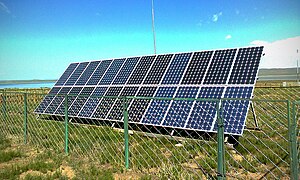 | |
| Hyro Turbine |
Michael Kostrzewa, who co-directs the new Center for Agricultural Energy for CSU spoke about the importance of agricultural energy assessments. He defined energy assessments as a “systematic way to review the energy consumption and costs associated with the equipment, operations, and culture at a facility". He referred to energy assessments as “the veggies of the meal with renewable energy being the dessert”. Mr. Kostrzewa emphasized, just as 4CORE does, that the first step towards energy efficiency is an energy evaluation, whether professional or done by you. To start to assess your own energy use, start with a baseline of your energy bills.
- Electric energy
- Peak electric demand
- Diesel (farm vehicles, farm equipment, other vehicles)
- Propane
- Natural Gas
- Pesticides
- Fertilizer
Solar
Kurt Jones, Chaffee and Park County Colorado State University Extension Director, spoke about the benefits and drawbacks of solar thermal, photovoltaic, and passive solar design. He emphasized the care of the building structure that has potential for solar energy. If work would need to be done to the building within the next ten years, he suggested doing the work before installing a solar system, as well as any energy efficient upgrades. Completing the energy efficient upgrades before any renewable energy enters the equation is a benefit because the size of a system could be smaller if a building is operating as efficiently as possible. Find more information on the CSU website or contact Mr. Jones directly at 719-395-5493.
A tip for farmers in the winter: Paint the south facing side of the stock tank black to absorb the suns energy and keep ice from forming.
Hydro Power
Hydro power is producing electricity with running water. There are a few initial questions to ask to determine if you have a good/economical site. First, what are the hydraulic conditions, or how is the water moving? What is the head or how much distance is between the starting point of the water flow to the end point? These starting and end points are often in the middle of the water way. Height decreases, such as water falls are good examples of this. Measure the distance between the top of the water fall where the grade evens out. Check the flow rate, or how fast the water is moving, and assess how long the water moving at that rate. Another point to assess is wildlife habitat. Would a turbine negatively affect fish or other wildlife habitat?
Once these basic questions are answered, it’s time to call in a professional. Colorado specifically has been designated with high potential for hydro power. There are many water ways winding throughout this state that are just waiting to be utilized.
Now all this made hydro power sound easy, but it’s not. Obtaining permits and jumping through all the right hoops can make this process arduous. There are funding opportunities that include feasibility and construction funding, and tax credits. If you think you have a good site for hydro power, contact Lindsay George at (970) 945 – 9686 with Applegate.
Biodiesel
Biodiesel is the byproduct of a byproduct. So a farmer grows some soy beans, harvests them, presses them, then uses the soy meal for his animals. The oil is left over from pressing them. That oil can be taken and converted into fuel for the farmers tractors. Biodiesel is better for the environment because it’s free of sulfates and has a lesser amount of nitrates then crude oil or petroleum. You can grow your own crops for biodiesel or you can gather the waste grease from restaurants.
Did you know you can “wash and dry” biodiesel? In fact, it’s necessary. It’s an important part of the process where water and biodiesel are put into the same container for at least 12 hours. When a successful wash has taken place the biodiesel will be at the top of the container, with the water at the bottom. If this separation hasn’t occurred you basically have soap. The drying process is letting that water be evaporated so you are only left with pure biodiesel. Find a more comprehensive description of the process here: http://www.make-biodiesel.org/.
4CORE and Colorado State University Extension and Research Centers have lots of information and are always willing to help guide you in the right direction when looking into renewable energy applications.
www.fourcore.org
http://www.ext.colostate.edu/index.html
About the Author:
Heather Wyatt recently received her Bachelor's Degree from Fort Lewis College in Psychology. She thoroughly enjoys people and is excited to see all the different ways the Weatherization Program will help others. She has experience in managing small businesses and working with people from different backgrounds. She enjoys watching movies and working in the yard on weekends.



No comments:
Post a Comment